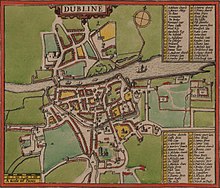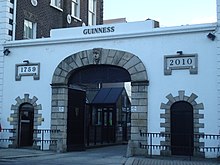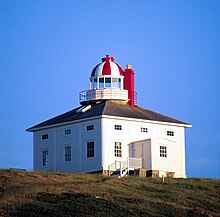세인트 제임스의 문
St. James's Gate더블린 남쪽 해안에 위치한 제임스 가에 있는 세인트 제임스 문은 중세 시대에 도시로 들어가는 서쪽 입구였다. 이 시기에 이 문은 더블린에서 갈리시아(스페인)의 산티아고 데 콤포스텔라까지 카미노 순례의 전통적인 출발점이었다.[1] 원래 중세문은 1734년에 철거되었지만,[2] 이 문은 자신이 위치한 지역에 그 이름을 붙였고,[3] 특히 성 제임스 문맥주 (1759년 아서 기네스에게 인수되었다)에 이름을 붙였다.[2]
중세 시문
성벽이 있는 도시로서 더블린의 주요 출입구는 시문으로 보호되었다. 성 제임스 문(St. James's Gate)은 이 도시의 서쪽 출입구로, 12세기 성 제임스의 교회와 교구의 이름을 따서 명명되었다.[4] 또한 성 제임스(St. James)의 이름을 따서 이름 붙여진 이 지역의 성스러운 우물은 오랜 여름 축제의 장소였다.[3]
최대 5세기 동안 서 있는 이 문은 시내로 들어오는 물건들의 통행료 징수소였다.[3][2] 13세기 문헌에 언급되어 있으며, 존 스피드의 17세기 더블린 지도와 찰스 브로킹의 18세기 초 도시 지도에 표시되어 있다.[4] 시간이 흐르면서 황폐해진 중세 문은 18세기 중반에 철거되었다.[2]
지역 양조
세인트 제임스 지역은 17세기 이후 양조 무역과 관련이 있다. 17세기 중반까지 더블린에 많은 양조장이 설립되었는데, 1670년경 세인트 제임스 문에서 알더만 자일스 미가 설립한 양조장이다.[5] 자일스 미는 더블린 주식회사로부터 세인트 제임스 게이트(이하 "파이프스"라 한다)의 수도권을 임대받았다.[6] 이러한 권리는 1700년에서 1701년 사이에 더블린의 시장이었던 시의 지명자인 그의 사위인 마크 레인스포드 경에게 전달되었다.[7] 레인스포드는 이러한 물 권리를 이용했고, 1693년의 행위에 따르면, 성 제임스 게이트에서 "비어있고 훌륭한 에일"을 생산하고 있었다.[8] 거기에는 또한 다른 맥주 회사들이 세인트 제임스의 문(물 공급이 지역에서 이용할 수 있기 때문에.)근처에 놓이고 Rainsford의 기업은 다른 사람들과 다르지 않았다.(그 당시는 양조에 제거되어 오염 물질을 포함한 맥주와 에일이 상품 제품들이 더 많은 일반적으로 물보다 소비되었다.-.) 있었다.[표창 필요한] 마크 레인스포드 경은 1709년에 사망했고 임대 계약은 그의 아들 마크 레인스포드 에스크에게 넘어갔다. 1715년 레인스포드 호는 그 건물을 임대하기 위해 세를 들였고 그것은 선장 폴 에스피나스에 의해 점령되었다. 에스피나세는 그 유적지와 도시의 접근을 용이하게 하기 위해 원래의 중세 문들을 철거하는 데 역할을 했다고 한다.[9] 에스피나스는 1750년 드로게다의 블랙불 여관 근처에서 말에서 떨어져 죽었다.[10]
10년 동안 양조장 부지는 시장에 나와 있었고, 1759년까지 임대 계약은 마크 레인스포드 경의 손자인 제3의 마크 레인스포드의 손에 맡겨졌다. 아서 기네스는 이 구내에 관심을 가졌고, 1759년 12월 31일, 이 임대 계약은 9,000년 동안 매년 45파운드로 기네스에 양도되었다.[11] 이 장소는 그 이후로 기네스 양조장이 위치한 곳이다. 기네스북은 원래 4에이커의 땅을 훨씬 뛰어넘어 확장되었고, 결과적으로 그 부동산을 매입하여 1759년부터 9,000년의 임대 기간을 중복으로 만들었다.[12]
참조
- ^ "The Pilgrimage". Irish Society of the Friends of St.James. Archived from the original on 7 October 2011.
- ^ a b c d "Archive Fact Sheet: St. James's Gate" (PDF). guinness-storehouse.com. Archived from the original (PDF) on 15 November 2018.
The medieval gate of St. James was demolished in 1734, 25 years before Arthur Guinness took over the Brewery on the site
- ^ a b c Stephen Mansfield (2009). The Search for God and Guinness: A Biography of the Beer that Changed the World. Nelson. ISBN 9781418580674.
Called St. James's Gate because of the church and parish by that name nearby, it stood for five centuries before crumbling to the ground. The name was retained for the location though, largely because there had been a holy well on the site that was the centrepiece for an annual summer festival
- ^ a b Bill Yenne (2007). Guinness: The 250 Year Quest for the Perfect Pint. John Wiley & Sons. ISBN 9780470120521.
St. James's Gate was the ancient entrance to the city from the suburbs to the west. It took its name from the Church and Parish of St. James, which date back to the twelfth century. The gate is mentioned in the thirteenth century and shown both on Speed's 1610 map of Dublin and on Brooking's 1729 map of the city
- ^ "Dublin City Archives - Record reference 'vital:5380' - WSC.Maps.563.face". libraries.dublincity.ie. Dublin City Archives. Archived from the original on 20 November 2018. Retrieved 19 November 2018.
Map of a parcel of ground, called “The Pipes”, in the parish of St. James and County Dublin. Leased to Giles Mee in 1670, from the Cistern at James’s Gate in 1670
- ^ Adrian MacLoughlin (1979). Historic Dublin. Gill and Macmillan. p. 166.
- ^ Desmond F. Moore (October 1960). "The Guinness Saga". Dublin Historical Record. 16 (2): 50–57. JSTOR 30082541.
- ^ Guinness & Co Ltd (1928). Guide to St. James's Gate Brewery. Arthur Guinness, Son & Co Ltd. pp. 21–22.
When the first brewery was set up at St. James's Gate is not on record. In the year 1670 one Giles Mee, a brewer, obtained [rights. These passed to] Sir Mark Rainsford, brewer, of St. James's Gate. Documents preserved in the Public Registry of Deeds, Dublin, record that in the year 1693 Alderman Sir Mark Rainsford had a brewhouse at St. James's Gate where "beer and fine ales" were made.
- ^ Joseph Brady, Anngret Simms (2001). Dublin: through space and time (c. 900-1900). Four Courts. p. 80. ISBN 9781851826414.
In 1734, when recommending the demolition of the building over St James' Gate [..] Captain Paul Espinasse proposed that he pull down the gate and give a foot of ground on its south side to enlarge the passage, a proposal promptly accepted by the Corporation
CS1 maint: 작성자 매개변수 사용(링크) - ^ Guinness & Co Ltd (1952). Guinness, Dublin. Hely's Limited.
[Rainsford leased] the St. James's Gate premises to Paul Espinasse, who carried on the brewing business there until 1750, when he was unfortunately killed by a fall from his horse at Drogheda
- ^ "Sir Arthur Guinness". gallot.co.nz. Archived from the original on 18 September 2009. Retrieved 3 December 2009.
- ^ "Guinness Storehouse FAQ". Guinness-Storehouse.com. Archived from the original on 11 July 2011. Retrieved 18 March 2012.
Q:I s the 9,000 year lease still valid? A: The 9,000 year lease signed in 1759 was for a 4 acre brewery site. Today, the brewery covers over 50 acres, which grew up over the past 200 years around the original 4 acre site. The 1759 lease is no longer valid as the Company purchased the lands outright many years ago




